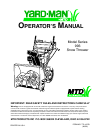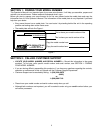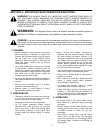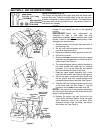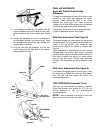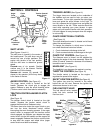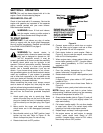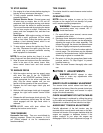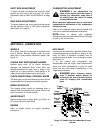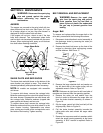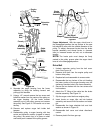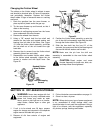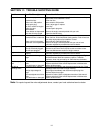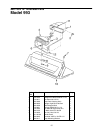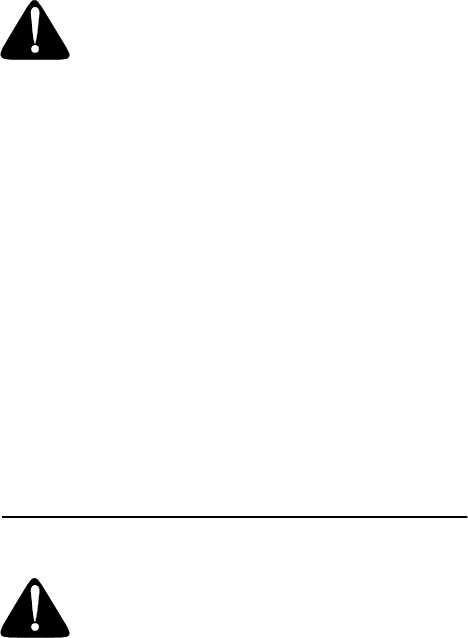
9
TO STOP ENGINE
1. Run engine for a few minutes before stopping to
help dry off any moisture on the engine.
2. To help prevent possible freeze-up of starter,
proceed as follows:
Optional Electric Starter Connect power cord
to switch box on engine, then to 120 volt AC
receptacle. With the engine running, push starter
button and spin the starter for several seconds.
The unusual sound made by spinning the starter
will not harm engine or starter. Disconnect the
power cord from receptacle first, and then from
switch box.
Recoil Starter With engine running, pull starter
rope with a rapid, continuous full arm stroke
three or four times. Pulling the starter rope will
produce a loud clattering sound, which is not
harmful to the engine or starter.
3. To stop engine, remove the ignition key. Do not
turn key. Disconnect the spark plug wire from
the spark plug to prevent accidental starting
while equipment is unattended.
NOTE: Do not lose ignition key. Keep it in a safe
place. Engine will not start without the ignition key.
4. Wipe all snow and moisture from the carburetor
cover in the area of the control levers. Also,
move control levers back and forth several
times.
TO ENGAGE DRIVE
1. With the engine running near top speed, move
shift lever into one of the six FORWARD
positions or two REVERSE positions. Select a
speed appropriate for the snow conditions that
exist. Use the slower speeds until you are
familiar with the operation of the snow thrower.
2. Squeeze the left hand auger clutch grip and
engage it.
3. While the left hand auger clutch grip is engaged,
engage the right hand traction control clutch
grip.
4. Release the left hand auger clutch grip only. The
interlock mechanism should keep the left hand
clutch engaged until the right hand clutch is
released.
NOTE: NEVER move shift lever without first
releasing the traction control clutch.
TIRE PRESSURE
Pneumatic tires only Tires are over-inflated for
shipping purposes. Correct tire pressure is 10-15
psi. (Check sidewall of tire for manufacturer’s
recommendation.)
TIRE CHAINS
Tire chains should be used whenever extra traction
is needed.
OPERATING TIPS
NOTE: Allow the engine to warm up for a few
minutes as the engine will not develop full power
until it reaches operating temperature.
WARNING: Temperature of muffler and
surrounding areas may exceed 150° F.
Avoid these areas.
1. For most efficient snow removal, remove snow
immediately after it falls.
2. Discharge snow downwind whenever possible.
The distance snow is thrown can be adjusted by
adjusting the angle of the chute assembly. The
sharper the angle, the shorter the distance snow
is thrown. Slightly overlap each previous swath.
3. Set the skid shoes 1/4” below the shave plate for
normal usage. The skid shoes may be adjusted
upward for hard-packed snow. Adjust downward
when using on gravel or crushed rock.
4. Be certain to follow the precautions listed under
previous section, “To Stop Engine” to prevent
possible freeze up.
5. Clean the snow thrower thoroughly after each
use.
SECTION 7: ADJUSTMENTS
WARNING: NEVER attempt to clean
chute or make any adjustments while
engine is running.
REMOTE CHUTE ASSEMBLY ADJUSTMENT
The remote chute control cables have been pre-
adjusted at the factory. Move the remote chute lever
on the control panel back and forward to adjust
angle of the chute assembly.
CHECK ADJUSTMENT OF CLUTCH CABLES
Proper adjustment is achieved by sliding the spring
up the cable and threading the nut in or out. Correct
adjustment on cables is minimal slack but not tight.
AUGER BELT TENSION ADJUSTMENT
Periodic adjustment of the belt tension may be
required due to normal stretch and wear on the belt.
Increase belt tension if the augers hesitate while the
augers are engaged or decrease tension if the
augers continue to turn when the augers are
disengaged. Refer to Proper Adjustment on page 12.



